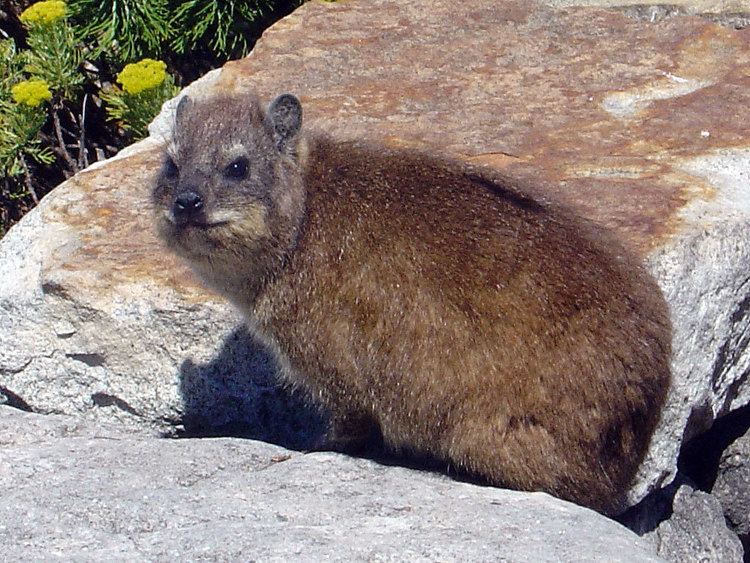This is a list of the mammal species recorded in Yemen. There are 69 mammal species in Yemen, of which 0 are critically endangered, 2 are endangered, 7 are vulnerable, and 3 are near-threatened. 2 of the species listed for Yemen is extinct.
The following tags are used to highlight each species' conservation status as assessed by the IUCN:
Some species were assessed using an earlier set of criteria. Species assessed using this system have the following instead of near threatened and least concern categories:
The hyraxes are any of four species of fairly small, thickset, herbivorous mammals in the order Hyracoidea. About the size of a domestic cat they are well-furred, with rounded bodies and a stumpy tail. They are native to Africa and the Middle East.
Family: Procaviidae (hylaxes)Genus: ProcaviaCape hyrax Procavia capensis LCSirenia is an order of fully aquatic, herbivorous mammals that inhabit rivers, estuaries, coastal marine waters, swamps, and marine wetlands. All four species are endangered.
Family: DugongidaeGenus: DugongDugong Dugong dugon VUThe order Primates contains humans and their closest relatives: lemurs, lorisoids, monkeys, and apes.
Suborder: HaplorhiniInfraorder: SimiiformesParvorder: CatarrhiniSuperfamily: CercopithecoideaFamily: Cercopithecidae (Old World monkeys)Genus: PapioHamadryas baboon Papio hamadryas LR/ntRodents make up the largest order of mammals, with over 40 percent of mammalian species. They have two incisors in the upper and lower jaw which grow continually and must be keep short by gnawing. Most rodents are small though the capybara can weigh up to 45 kg (100 lb).
Suborder: SciurognathiFamily: Dipodidae (jerboas)Subfamily: DipodinaeGenus: jaculusLesser Egyptian jerboa Jaculus jaculus LCFamily: Muridae (mice, rats, voles, gerbils, hamsters, etc.)Subfamily: DeomyinaeGenus: AcomysCairo spiny mouse Acomys cahirinus LCGolden spiny mouse Acomys russatus LR/lcSubfamily: GerbillinaeGenus: GerbillusCheesman's gerbil Gerbillus cheesmani LR/lcWagner's gerbil Gerbillus dasyurus LR/lcBlack-tufted gerbil Gerbillus famulus LR/lcPygmy gerbil Gerbillus henleyi LCGerbillus nanus LCLarge Aden gerbil Gerbillus poecilops LR/ntGenus: MerionesKing jird Meriones rex LR/lcSubfamily: MurinaeGenus: MyomyscusYemeni mouse Myomys Yemeni LR/lcThe order Erinaceomorpha contains a single family, Erinaceidae, which comprise the hedgehogs and gymnures. The hedgehogs are easily recognised by their spines while gymnures look more like large rats.
Family: Erinaceidae (hedgehogs)Subfamily: ErinaceinaeGenus: HemiechinusDesert hedgehog Hemiechinus aethiopicus LR/lcThe "shrew-forms" are insectivorous mammals. The shrews and solenodons closely resemble mice while the moles are stout-bodied burrowers.
Family: Soricidae (shrews)Subfamily: CrocidurinaeGenus: CrociduraArabian shrew Crocidura arabica LR/lcThe bats' most distinguishing feature is that their forelimbs are developed as wings, making them the only mammals in the world naturally capable of flight. Bat species account for about 20% of all mammals.
Family: Pteropodidae (flying foxes, Old World fruit bats)Subfamily: PteropodinaeGenus: EidolonStraw-coloured fruit bat Eidolon helvum LCGenus: RousettusEgyptian fruit bat Rousettus aegyptiacus LCFamily: VespertilionidaeSubfamily: MyotinaeGenus: MyotisRufous mouse-eared bat Myotis bocagii LCSubfamily: VespertilioninaeGenus: EptesicusBotta's serotine Eptesicus bottae LCSind bat Eptesicus nasutus VUGenus: HypsugoBodenheimer's pipistrelle Hypsugo bodenheimeri LR/ntGenus: NycticeinopsSchlieffen's twilight bat Nycticeinops schlieffeni LCGenus: PipistrellusKuhl's pipistrelle Pipistrellus kuhlii LCSubfamily: MiniopterinaeGenus: MiniopterusSchreibers' long-fingered bat Miniopterus schreibersii LCFamily: RhinopomatidaeGenus: RhinopomaLesser mouse-tailed bat Rhinopoma hardwickei LCGreater mouse-tailed bat Rhinopoma microphyllum LCFamily: MolossidaeGenus: ChaerephonLittle free-tailed bat Chaerephon pumila LCGenus: OtomopsLarge-eared free-tailed bat Otomops martiensseni NTGenus: TadaridaEgyptian free-tailed bat Tadarida aegyptiaca LCFamily: EmballonuridaeGenus: ColeuraAfrican sheath-tailed bat Coleura afra LCFamily: NycteridaeGenus: NycterisEgyptian slit-faced bat Nycteris thebaica LCFamily: RhinolophidaeSubfamily: RhinolophinaeGenus: RhinolophusBlasius's horseshoe bat Rhinolophus blasii NTGeoffroy's horseshoe bat Rhinolophus clivosus LCSubfamily: HipposiderinaeGenus: AselliaTrident leaf-nosed bat Asellia tridens LCGenus: HipposiderosSundevall's roundleaf bat Hipposideros caffer LCGenus: TriaenopsPersian trident bat Triaenops persicus LCThe order Cetacea includes whales, dolphins and porpoises. They are the mammals most fully adapted to aquatic life with a spindle-shaped nearly hairless body, protected by a thick layer of blubber, and forelimbs and tail modified to provide propulsion underwater.
Suborder: MysticetiFamily: BalaenopteridaeSubfamily: BalaenopterinaeGenus: BalaenopteraBryde's whale Balaenoptera edeni♠ DDSubfamily: MegapterinaeGenus: MegapteraHumpback whale Megaptera novaeangliae♠ VUSuborder: OdontocetiSuperfamily: PlatanistoideaFamily: Physeteridae (sperm whales)Genus: PhyseterSperm whale Physeter macrocephalus♠ VUFamily: KogiidaeGenus: KogiaPygmy sperm whale Kogia breviceps♠ LR/lcDwarf sperm whale Kogia sima♠ LR/lcFamily: ZiphidaeSubfamily: HyperoodontinaeGenus: IndopacetusLongman's beaked whale Indopacetus pacificus♠ DDGenus: MesoplodonBlainville's beaked whale Mesoplodon densirostris♠ DDFamily: Delphinidae (marine dolphins)Genus: StenoRough-toothed dolphin Steno bredanensis♠ DDGenus: SousaSousa chinensis♠ DDGenus: TursiopsCommon bottlenose dolphin Tursiops truncatus♠ DDIndo-Pacific bottlenose dolphin Tursiops aduncus♠ DDGenus: StenellaSpinner dolphin Stenella longirostris♠ DDPantropical spotted dolphin Stenella attenuata♠ LR/cdGenus: DelphinusCommon dolphin Delphinus capensis♠ LR/lcGenus: LagenodelphisFraser's dolphin Lagenodelphis hosei♠ DDGenus: GrampusRisso's dolphin Grampus griseus♠ DDGenus: FeresaPygmy killer whale Feresa attenuata♠ DDGenus: PseudorcaFalse killer whale Pseudorca crassidens♠ ENThere are over 260 species of carnivorans, the majority of which feed primarily on meat. They have a characteristic skull shape and dentition.
Suborder: FeliformiaFamily: Felidae (cats)Subfamily: FelinaeGenus: CaracalCaracal Caracal caracal LCGenus: FelisSand cat Felis margarita NTWildcat Felis silvestris LCSubfamily: PantherinaeGenus: PantheraArabian leopard Panthera pardus nimr CRFamily: Viverridae (civets, mongooses, etc.)Subfamily: ViverrinaeGenus: GenettaCommon genet Genetta genetta LR/lcFamily: Herpestidae (mongooses)Genus: IchneumiaWhite-tailed mongoose Ichneumia albicauda LR/lcFamily: Hyaenidae (hyaenas)Genus: HyaenaStriped hyena Hyaena hyaena NTSuborder: CaniformiaFamily: Canidae (dogs, foxes)Genus: VulpesBlanford's fox Vulpes cana LCRueppell's fox Vulpes rueppelli LCGenus: CanisGolden jackal Canis aureus LCGray wolf Canis lupus LCFamily: Mustelidae (mustelids)Genus: MellivoraRatel Mellivora capensis LCThe even-toed ungulates are ungulates whose weight is borne about equally by the third and fourth toes, rather than mostly or entirely by the third as in perissodactyls. There are about 220 artiodactyl species, including many that are of great economic importance to humans.
Family: Bovidae (cattle, antelope, sheep, goats)Subfamily: AntilopinaeGenus: GazellaQueen of Sheba's gazelle Gazella bilkis EXDorcas gazelle Gazella dorcas VUMountain gazelle Gazella gazella VUSaudi gazelle Gazella saudiya EXGoitered gazelle Gazella subgutturosa VUSubfamily: CaprinaeGenus: CapraNubian ibex Capra nubiana VUSubfamily: HippotraginaeGenus: OryxArabian oryx Oryx leucoryx VU - regionally extinct
